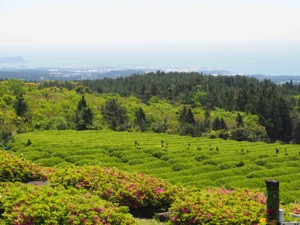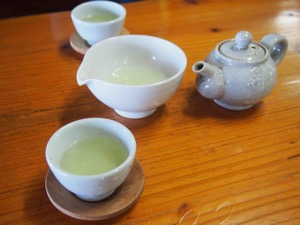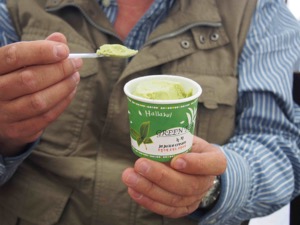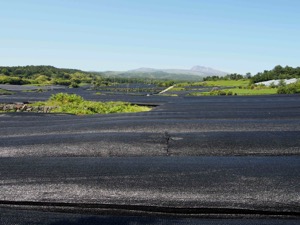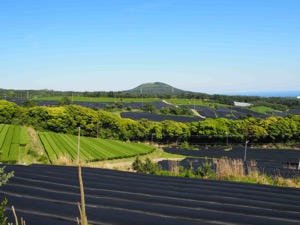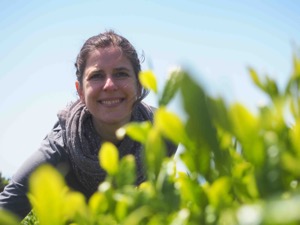Finally finding the tea plantations on Jeju Island
We wake up with sun and have breakfast with a very nice view on the ocean. I am getting optimistic, that today we will find the tea plantations. We have a map and an idea where they are and after a ride with nice views on the central volcanic mountain of Jeju Island we finally see the sign to the Jeu Island Green Tea Farm.
The tea plants look less straight cut than we are used from the tea plantations in Japan. Some are with just little leaves, but the view on the surrounding mountains and the sea is just stunning. All in all the arrangement of the plants planted in rows look similar to the japanese tea plantations. We go to the little teahouse and shop, where we are invited to taste the green panfired tea.
It is interesting to see how the tea is prepared and served in comparison to Japan. In Korea they hotter water for preparing the tea in a little teapot with an integrated strainer. After a short time they pour the tea into a cooling vessel to prevent that it is getting bitter. Form the vessel they serve the tea into small tea cups. In Japan it would be the other way around. The water would first go into the cooling vessel, for than preparing the tea with the just slightly hot water in the also small teapot (kyusu) with the handle on the side.
We are pretty much surprised of the fresh green flavour of the tea. At first we are a bit irritated that they name it roasted green tea. The delicate flavour has nothing to do with the slightly roasted Houjicha tea we know from Japan. Than we get to know Mr. Go, who works already for a long time at the plantation. He explains to us, that these teas are not steamed, but prepared in a fired pan like in China. That explains why they name their teas roasted tea.
Mr. Go tells us, that the whole plantation was planted at once 20 years ago all plants are the japanese variety Yabukita. In Jeju Tea Maze Garden all teas are hand picked and than produced by hand in the fired pans. Out of 1 kilogram picked leaves they get about 200g tea. For the premium tea they just pick the very tiny buts. Than these fragile leaves are processed with biggest care. We buy a 20g bag of this very expensive tea and another bay of the medium and average quality, which we are looking forward to taste.
Than we have Korean lunch and green tea ice cream for desert, which is not as delicious and creamy as we know it from Japan.
With new energy we start searching for the other tea plantation, we have heard of. It takes us a while to find it, but than we see the big shaded (kabuse) fields, we know from Japan. A bit unsure, if we can drive through or not, we pass the open gate without any sign. We are pretty much surprised by the extension of the tea fields, which are almost all covered by black shading nets. In the distance we see working three of the harvesting machines we know from Japan. The dimension of this tea plantation is really big.
When we reach the tea fabric we see a truck unloading the tealeaves. It smells and looks very much like Yabukita. Unfortunately it is not possible to communicate to the workers as they don’t speak English. Later two young Korean ladies, which are here on holiday, explain us that we can not bur tea here at the fabric, but at the Shop at the Ossoluc Tea Museum. It looks like that the tea harvested and produced here is part of the Ossoluc tea production. For tomorrow we have an appointment at Ossoluc and for sure will find out more details. We are curious to taste more Korean green tea and are looking very much forward for tomorrow.
 Português
Português English
English Español
Español